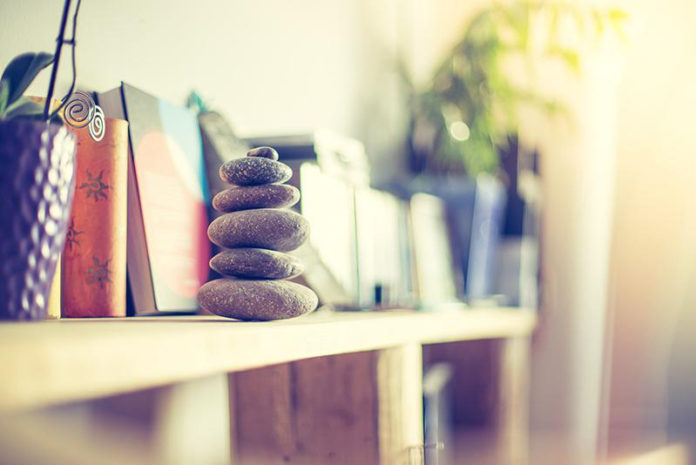At home, we all want a sense of familiar warmth to make it feel more comfortable. When you move into a new space or redecorate your home, keep that idea at the forefront. From scientific research to Feng Shui, we know that outdated and out-of-place furniture or blank walls can mess with your mood and energy.
Have you ever slept in a house with intense paint colors in the bedroom? If so, you likely didn’t sleep much. Sometimes the layout of a room or entire home can put you in a funk. With some research, you can use decor to energize you and facilitate a healthy lifestyle. Let’s uncover some of the ways you can decorate and arrange your space for a positive effect on your health.
Lighting for More Energy
The lighting in your home helps dictate your body’s circadian rhythm. You may recall my article that explained how the foods you eat could affect your circadian rhythm. According to scientific research in the Open Sleep Journal, the simple light bulbs could be disrupting your sleep cycle more than you realize.
Choose light bulbs per your age. The human eye absorbs and converts a wide range of luminance throughout day and night. Our retina sends neurological signals to our brain in a process called phototransduction. The human visual system copes with the variance in nighttime and daytime light levels in a process called adaptation.
In a typical office, light levels are ideal for young adults with eyes at their peak performance. However, the degraded efficiency of eyesight that naturally occurs with age requires a more careful lighting setup for healthy sleep and overall health.
Your circadian rhythm also depends much on your current lifestyle and occupation. For example, an older person who spends a whole day in a room with dim lights will suppress more melatonin at night. Compare that with a farmer who spends the day outside in natural light.
In a nutshell, according to the Open Sleep Journal study “light applied after wake-up time will cause one to go to bed earlier and wake up earlier while light applied before bedtimes will cause one to go to bed later and wake up later.”
Colors and Your Health
Make the color of your walls a priority. As I mentioned earlier, bright colors in a bedroom are not conducive to sleep. Psychologists have been studying this topic for a long time. Goethe in 1810 discussed in “Theory of Colors” that there are “plus” colors: yellow, red-yellow, yellow-red, which stimulate warmth and excitement. They produce a systematic physiological reaction in the emotional experience, cognitive orientation, and overt action.
You have likely noticed that when a person is full of anger or testosterone, their face turns bright red. Similarly, in animals, Hill and Barton (2005) found that bright red evoked dominance, likely due to its semblance to oxygenated blood. These correlations between skin coloration and a physiological response come into play with your home decor, too. The colors affect your life in a subtle, subconscious way.
The colors can also take your mood and energy in the opposite direction. A study in the Scandinavian Journal of Work, Environment & Health, showed that blue-enriched light improved workers’ performance in an office and also sleep quality. Therefore, it is no surprise that grays, blues, and other muted tones can help you gain healthy REM sleep cycles.
When it comes to the bedroom, avoid those fun and exciting oranges, yellows, and red hues. Instead, opt for calm tones, like neutrals or soft pink, peach, and tan.
Healthy Living Decor and Objects
Cultivating a healthy home takes more than paint. Include healthful objects such as an essential oil diffuser or air purifier to promote wellness. Even better than an air purifier is a natural equivalent–plants! Include living plants in your home for healthier indoor air. While air cleaners with HEPA filters may improve asthma, they do not reduce levels of all indoor air pollutants.
There’s nothing better than the natural air filtration of photosynthesis. Indoor plants remove toxins from air, soil, and water in two ways. They metabolize toxic chemicals and incorporate heavy metals into plant tissues like a sponge. These are a few reasons why I recommend indoor plants in every room of the house if possible.
House plants will also reduce stress and anxiety, According to a study published in the Journal of Physiological Anthropology. Plants can also help you heal. A Kansas State University research recommends potted plants and flowers as a “noninvasive, inexpensive, and effective complementary medicine for surgical patients.”
Rearrange Your Furniture and Your Life
You’ve probably heard of Feng Shui. Feng Shui originates from the design of temples in ancient China, more than 6,000 years ago. It involves incorporating respect for nature and earth into the design and allowing energy to flow.
Eastern medicine studies chakras and the flow of chi (energy) for health. The way you arrange your home can affect this energy flow for better or worse.
Feng Shui incorporates color, sound, and lighting, and it all can affect your mood. An example of Feng Shui is that your bed should not directly face the door, as this is known as the “coffin position.” There’s not a lot of scientific research to back up Feng Shui, but there are millennia of tradition because so many people follow and believe the effectiveness of the practice.
So if you’re looking for a mental boost or even perhaps career success, do yourself a favor and pick up a book on Feng Shui. Find out the best arrangement of furniture and objects for the health of your household.
Now that you’re thinking about a healthy living space, make it a goal to practice other healthy habits within your home beyond the arrangement and decor. You have to do your part, which means eating nutritious foods and living an active lifestyle.








